A Jobless Economic Recovery or Something Else?
Stock-Markets / Financial Markets 2009 Oct 02, 2009 - 04:38 PM GMT U.S. job losses accelerated last month and the unemployment rate climbed to the highest level since 1983, stark reminders of how the worst financial crisis in a generation may undermine consumer spending and economic growth in the months ahead.
U.S. job losses accelerated last month and the unemployment rate climbed to the highest level since 1983, stark reminders of how the worst financial crisis in a generation may undermine consumer spending and economic growth in the months ahead.
The figures from today’s Labor Department report sent stocks tumbling for a fourth day and yields on benchmark 10-year notes to the lowest level since May. The report underscores forecasts for the Federal Reserve to keep its benchmark interest rate near zero through next year, and may spark calls for stronger government efforts to shore up jobs.
Banks are being swamped with bad loans.
The number of U.S. lenders that can’t collect on at least 20 percent of their loans hit an 18-year high, signaling that more bank failures and losses could slow an economic recovery. While regulators may not force firms on the list to close, requiring them to raise capital and curb loans may impede recovery in Florida, Illinois and seven other states. The banks are among the most vulnerable of a larger group of lenders whose failures the FDIC said could cost $100 billion by 2013.
Bank accounting “flying blind.”
There was a stunning omission from the government’s latest list of “problem” banks, which ran to 416 lenders, a 15-year high, as of June 30. One outfit not on the list was Georgian Bank, the second-largest Atlanta-based bank, which supposedly had plenty of capital. It failed last week.
A time for caution?
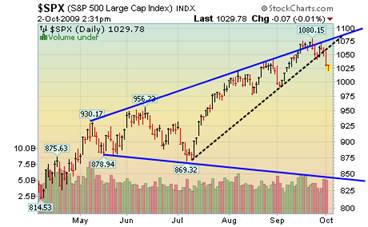 --Stock market weakness over the last few sessions -- especially the drop of 200-plus points suffered in the Dow industrials on Thursday -- certainly appears out of character for a stock market rally that has otherwise been one of the strongest in history. But, actually, that weakness is entirely in keeping with the seasonal tendency that goes by the name "Sell in May and Go Away." That seasonal weakness, of course, won't formally come to an end until Oct. 31. A time for caution, perhaps?
--Stock market weakness over the last few sessions -- especially the drop of 200-plus points suffered in the Dow industrials on Thursday -- certainly appears out of character for a stock market rally that has otherwise been one of the strongest in history. But, actually, that weakness is entirely in keeping with the seasonal tendency that goes by the name "Sell in May and Go Away." That seasonal weakness, of course, won't formally come to an end until Oct. 31. A time for caution, perhaps?
Treasuries meet overhead resistance.
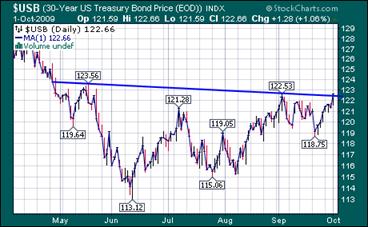 -- Treasuries fell as yields near the lowest levels in more than four months deterred investors from adding to holdings with the government scheduled to sell $78 billion in notes and bonds next week.
-- Treasuries fell as yields near the lowest levels in more than four months deterred investors from adding to holdings with the government scheduled to sell $78 billion in notes and bonds next week.
Treasuries handed investors a return of 2.1 percent in the period from July to September, according to Merrill Lynch & Co. indexes, as signs the recovery may be slow drove speculation the Federal Reserve will keep interest rates near historic lows. That was the strongest three-month performance since the last quarter of 2008.
Gold suffers a turnaround.
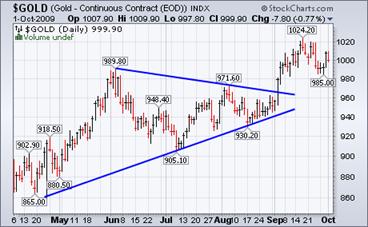 --Gold dropped in New York and London as the dollar strengthened to a three-week high against the euro and oil prices slid, curbing demand for the metal as an alternative investment and inflation hedge. Traders believe that the weakening economy will keep inflation in check and the threat of a rising dollar may dampen the ardor of investors toward gold.
--Gold dropped in New York and London as the dollar strengthened to a three-week high against the euro and oil prices slid, curbing demand for the metal as an alternative investment and inflation hedge. Traders believe that the weakening economy will keep inflation in check and the threat of a rising dollar may dampen the ardor of investors toward gold.
Japanese stocks are in a slump.
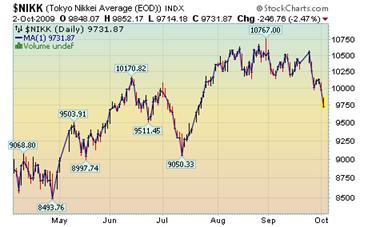 -- Japanese stocks fell, capping their third-straight weekly slump, after an unexpected drop in the nation’s joblessness rate failed to convince investors the economy is improving. The Nikkei and Topix weekly slumps were their steepest since the five days ended July 10, after Nomura Holdings Inc. announced a record $5.6 billion share sale and a Bank of Japan survey showed companies planned to further cut investment.
-- Japanese stocks fell, capping their third-straight weekly slump, after an unexpected drop in the nation’s joblessness rate failed to convince investors the economy is improving. The Nikkei and Topix weekly slumps were their steepest since the five days ended July 10, after Nomura Holdings Inc. announced a record $5.6 billion share sale and a Bank of Japan survey showed companies planned to further cut investment.
Property stocks lead China’s stock index down.
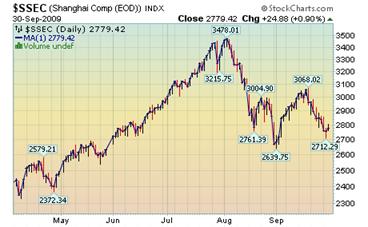 -- China’s benchmark for property stocks is close to slipping below its 200-day moving average, signaling losses in global stocks and commodities and gains in the U.S. dollar, according to Bank of America Corp. “Watch the Shanghai property index in coming weeks,” Hartnett said in the report entitled “world’s lead indicator on a precipice.” The index “sits precariously on its 200-day moving average. China property stocks are the nexus of China’s growth, policy and excess liquidity,” he wrote.
-- China’s benchmark for property stocks is close to slipping below its 200-day moving average, signaling losses in global stocks and commodities and gains in the U.S. dollar, according to Bank of America Corp. “Watch the Shanghai property index in coming weeks,” Hartnett said in the report entitled “world’s lead indicator on a precipice.” The index “sits precariously on its 200-day moving average. China property stocks are the nexus of China’s growth, policy and excess liquidity,” he wrote.
World finance ministers need a strong dollar.
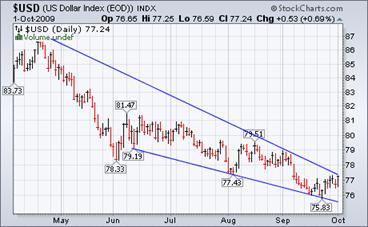 -- Finance chiefs headed for Group of Seven talks in Istanbul pushing for a “strong dollar” amid concern its slide will impede their recoveries from the worst global recession since World War II. “Everyone needs a strong dollar,” French Finance Minister Christine Lagarde told reporters in Gothenburg, Sweden, today as she met European Union counterparts. “We’ll have a chance to discuss this in the coming days.”
-- Finance chiefs headed for Group of Seven talks in Istanbul pushing for a “strong dollar” amid concern its slide will impede their recoveries from the worst global recession since World War II. “Everyone needs a strong dollar,” French Finance Minister Christine Lagarde told reporters in Gothenburg, Sweden, today as she met European Union counterparts. “We’ll have a chance to discuss this in the coming days.”
Housing faces a “shadow inventory.”
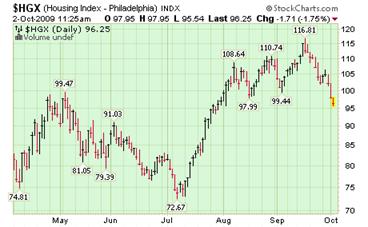 -- Any optimist talking up a housing recovery might want to pause and look deeper into the housing crisis. Amherst Securities Group analysts believe the market faces about 7 million properties that are likely to be seized by lenders have yet to hit the open market. There are two sources that contribute to a huge shadow housing inventory; ARM mortgages which are due to reset now through 2012 and current home owners who are struggling to make payments. Assuming no other properties are on the market, it would take 1.35 years to sell this inventory based on the current pace of existing-home sales, analyst Laurie Goodman.
-- Any optimist talking up a housing recovery might want to pause and look deeper into the housing crisis. Amherst Securities Group analysts believe the market faces about 7 million properties that are likely to be seized by lenders have yet to hit the open market. There are two sources that contribute to a huge shadow housing inventory; ARM mortgages which are due to reset now through 2012 and current home owners who are struggling to make payments. Assuming no other properties are on the market, it would take 1.35 years to sell this inventory based on the current pace of existing-home sales, analyst Laurie Goodman.
Midwest gasoline price at $2.38.
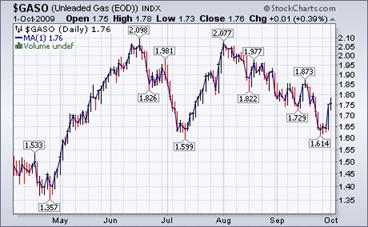 The Energy Information Administration Weekly Report suggests that, “The U.S. average price for regular gasoline declined for the seventh consecutive week. The average slipped five cents to $2.50 per gallon, bringing the cumulative drop for the past seven weeks to almost 15 cents. The national average was $1.13 below a year ago as prices fell throughout the country.”
The Energy Information Administration Weekly Report suggests that, “The U.S. average price for regular gasoline declined for the seventh consecutive week. The average slipped five cents to $2.50 per gallon, bringing the cumulative drop for the past seven weeks to almost 15 cents. The national average was $1.13 below a year ago as prices fell throughout the country.”
Economic recovery…or manipulation?
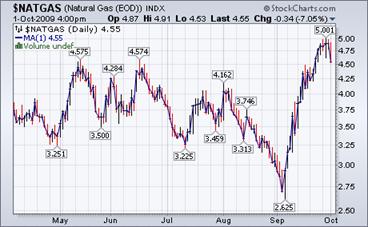 The Energy Information Agency’s Natural Gas Weekly Update reports, “Natural gas spot prices increased on the week at all market locations, except for a few trading points in the western half of the country. Increases ranged between 2 and 23 cents per MMBtu, although a majority of the trading locations saw prices rise by 12 to 18 cents on the week.”
The Energy Information Agency’s Natural Gas Weekly Update reports, “Natural gas spot prices increased on the week at all market locations, except for a few trading points in the western half of the country. Increases ranged between 2 and 23 cents per MMBtu, although a majority of the trading locations saw prices rise by 12 to 18 cents on the week.”
Can an Accounting Trick Rescue the FDIC?
Can an accounting trick save the Federal Deposit Insurance Corp.? That's what FDIC chief Sheila Bair and Co. seem to be hoping. On Tuesday, the cash-depleted FDIC hatched a plan to require banks to prepay three years of quarterly fees. The FDIC expects to quickly generate $45 billion in cash, an amount it normally would've had to wait years to get its hands on. But in a quirk of accounting rules, the banks won't have to expense the upfront payments this year, even though they will be handing over the cash in the next few months — in amounts that could run into the billions of dollars for some banks. The FDIC says the move will solve its liquidity problems — the FDIC officially slid into the red this week for the first time since 1991. But it's not certain whether the plan will boost confidence in the banking system, as the FDIC seems to hope.
On October 2, 1930…
Railcar loadings for week ended Sept. 20 were down 18.4% vs. 1929 and 16.7% vs. 1928; considered disappointing, largest percentage drop this year.
…and Today.
The Association of American Railroads today reported 271,659 carloads for the week ending Sept. 26, 2009, down 17.1 percent compared with the same week in 2008. For the first 38 weeks of 2009, U.S. railroads reported cumulative volume of 10,104,171 carloads, down 18.2 percent from 2008; 7,141,006 trailers or containers, down 16.8 percent, and total volume of an estimated 1.08 trillion ton-miles, down 17.3 percent. Total volume on U.S. railroads for the week ending September 26 was estimated at 28.8 billion ton-miles, off 17.2 percent from the same week last year.
Our Investment Advisor Registration is on the Web
We are in the process of updating our website at www.thepracticalinvestor.com to have more information on our services. Log on and click on Advisor Registration to get more details.
If you are a client or wish to become one, please make an appointment to discuss our investment strategies by calling Connie or Tony at (517) 699-1554, ext 10 or 11. Or e-mail us at tpi@thepracticalinvestor.com .
Anthony M. Cherniawski,
President and CIO
http://www.thepracticalinvestor.com
As a State Registered Investment Advisor, The Practical Investor (TPI) manages private client investment portfolios using a proprietary investment strategy created by Chief Investment Officer Tony Cherniawski. Throughout 2000-01, when many investors felt the pain of double digit market losses, TPI successfully navigated the choppy investment waters, creating a profit for our private investment clients. With a focus on preserving assets and capitalizing on opportunities, TPI clients benefited greatly from the TPI strategies, allowing them to stay on track with their life goals
Disclaimer: The content in this article is written for educational and informational purposes only. There is no offer or recommendation to buy or sell any security and no information contained here should be interpreted or construed as investment advice. Do you own due diligence as the information in this article is the opinion of Anthony M. Cherniawski and subject to change without notice.
Anthony M. Cherniawski Archive |
© 2005-2022 http://www.MarketOracle.co.uk - The Market Oracle is a FREE Daily Financial Markets Analysis & Forecasting online publication.



